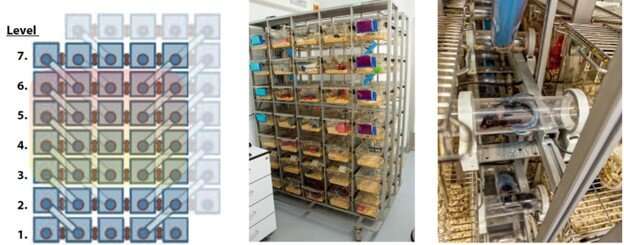This article has been reviewed according to Science X's editorial process and policies. Editors have highlighted the following attributes while ensuring the content's credibility:
fact-checked
peer-reviewed publication
trusted source
proofread
Tracking early signs of Alzheimer's pathology in a mouse model

About two-thirds of the risk for Alzheimer's disease (AD) is thought to arise from genetic influences, but about a third could be influenced by environment and lifestyle, opening the door for behavioral interventions that could delay or prevent pathophysiological changes that occur with AD. Now a new study in a mouse model of AD examines the effects of environmental enrichment on AD symptom progression and pathology. The study appears in Biological Psychiatry.
Gerd Kempermann, Ph.D., from the German Center for Neurodegenerative Diseases in Dresden, Germany, and senior author of the study, emphasized the importance of studying the early stages of disease, when interventions might be most effective.
Dr. Kempermann commented, "AD does not start when the symptoms become obvious. There is a decades-long silent period, during which the pathology progresses undetected. Clinicians and researchers have become increasingly interested in what happens during this phase."
To study this early pathology, Dr. Kempermann and colleagues used a mouse model of AD that replicates this silent period. The model contains several mutations associated with human AD in the gene encoding amyloid precursor protein (App). These AppNL-F mice develop toxic amyloid-beta plaques by age 6 months and cognitive impairment by 18 months.
Dr. Kempermann said, "However, we discovered that there are already subtle but important behavioral changes long before the first plaques appear, and the cognitive deficits become detectable."
The mice were housed in an enriched environment, which consisted of 60 interconnected cages, from age 6 weeks to 23 weeks and were then moved to standard cages after 4 months. Living in the enriched environment improved several measures of metabolism, which are known risk factors for AD.
Dr. Kempermann explained, "The [AD model] mice in our study showed a reduction in individual behaviors. They became more similar and more rigid. As this individualization is to a large degree driven by individual behavior and depends on brain plasticity, we can conclude that the affected mice had behavioral deficits very early in the course of the disease. They did not respond normally to the offerings of their environment."
"This finding is important, because it will help us to understand how we can best tailor preventive measures during the pre-clinical phase. It also underscores that prevention has to start early."
The researchers also examined markers of neurogenesis in the mice. Paradoxically, the AppNL-F mice had higher rates of neurogenesis than control mice, which is interpreted as a failing attempt at compensation and as paradoxically counterproductive. This overshooting compensation was normalized by exposure to enrichment.
John Krystal, MD, Editor of Biological Psychiatry, said of the work, "This novel study suggests that environmental enrichment may reduce the early accumulation of amyloid plaques in a mouse model of AD. This insight may suggest a strategy for delaying the development of symptoms associated with this disorder."
More information: Fanny Ehret et al, Pre-symptomatic reduction of individuality in the App NL-F knock-in model of Alzheimer's disease, Biological Psychiatry (2023). DOI: 10.1016/j.biopsych.2023.04.009


















